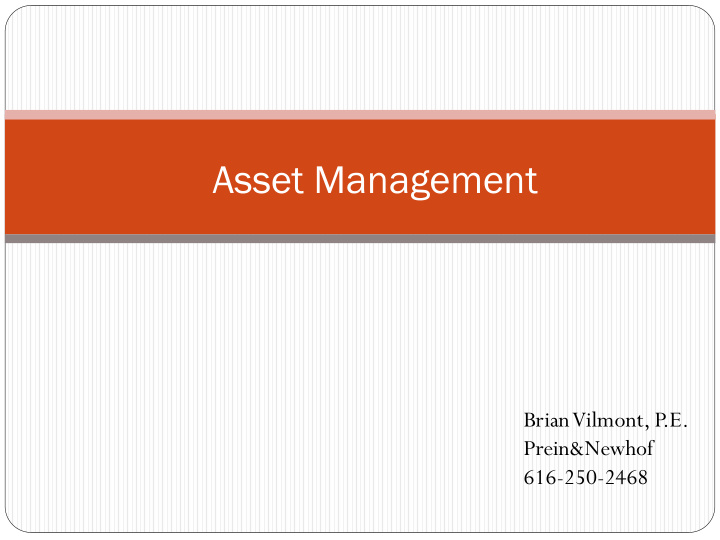



Asset Management Brian Vilmont, P .E. Prein&Newhof 616-250-2468
Common Questions What is Asset Management? Why should we do Asset Management? How do you implement Asset Management?
What is Asset Management? “Asset Management is an integrated set of processes to minimize life cycle costs of infrastructure assets, at an acceptable level of risk, while continuously delivering established levels of service.”
Why do Asset Management Get the most value from your assets Identify financial resources Reduce costs of unscheduled repairs Improve system reliability Promote communication between maintenance staff, management, and the public (saves re-work) Reduces risk
Infrastructure Assets What do infrastructure and opossums have in common? They both get no respect .
Design Life Cycles Sanitary Pipe 75 years Water 50 years Streets 20 years Storm 75 years Sidewalks 20 years Pathways 15 years Buildings Life cycle by components Pumps 15 years Controls 15 years
Design Life Cycles
How do you implement Asset Management Inventory your Assets 1. Prioritize the Risk of 2. Failure Plan for the Future 3. Implement the Plan 4.
Step 1 of Infrastructure Management Inventory your Assets Identify assets Mapping Condition assessment
Identify Assets Sewer system Collection and treatment Water system Supply and distribution Streets Storm sewers Buildings Pumps Controls
Create a Map of Assets Utilize geographic information system (GIS) to create asset maps Identification of individual assets Roads – block by block Sewers – segments between manholes Water mains – segments by block Pumps Controls Major equipment
Asset Maps - Roads • Surface Condition • Structural Integrity • Curbs • Sidewalks • Drive Approaches
Asset Maps - Water Main Age Materials Asbestos cement Cast iron Ductile iron PVC HDPE Break history Capacity (reliability) Fire flows
Asset Maps - Sanitary Sewer Infiltration and Inflow Study Capacity Analysis Sanitary Sewer Evaluation Study Manhole Inspections Television Inspection Smoke Testing Dye Testing
Asset Maps – Storm Sewer Infiltration and Inflow Study Capacity Analysis Storm Sewer Evaluation Study Manhole Inspections Television Inspection Smoke Testing Dye Testing Green Infrastructure
Facilities Water System Surface Water Intakes and Wells Metering and Chemical Feed Stations Treatment Plants Booster Pumping Stations Ground and Elevated Storage Tanks Storm and Sanitary System Pumping and Metering Stations Storage and Equalization Systems Treatment Plants Surface Water and Groundwater Discharge Systems
Facility Condition Assessment by System Structural/Architectural Systems Concrete foundations, walls, floors, slabs, beams and columns Masonry, windows, ceilings and roofs Mechanical/Process Systems Heating, Cooling and Ventilation Process Equipment (Pumps, Blowers, Chemical Feed, Mixers, Scrapers, Etc.) Process Piping, Plumbing and Coatings Electrical/Instrumentation Systems
Condition Assessment Initial assessment can be as straightforward as excellent, good, fair, marginal, and poor More detailed assessments can be added later
Infrastructure Catastrophes Happen
Infrastructure Catastrophes Happen
Infrastructure Catastrophes Happen
Identify Problem Areas Composite Deficiencies • Overlapping Issues • Project Coordination • Combined Projects • GIS (geographic information system)
Prioritize Known Problem Areas Water system Low-pressure areas Fire flow issues Frequent breaks Water quality issues
Identify Projects • Identify Critical Factors • Identify Project Extents • Probable Costs
Capital Improvement Plan • Funding Opportunities • Multi-Year Planning • Predictable Expenditures
React eactiv ive e or or Proactiv oactive How do you want to manage your assets?
THANK YOU! Contact for Information or Questions Brian Vilmont, P .E. Prein&Newhof 616-250-2468
Recommend
More recommend